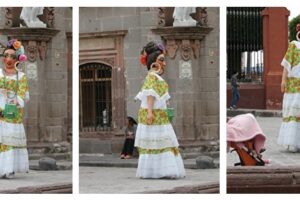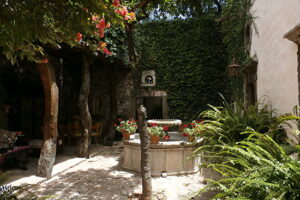A Sunday
Like most Sundays everywhere, the day begins as a lazy one. We have a late brunch and make plans on how to spend the afternoon. We are ambitious in all the things we want to do, so to fit in all that is on our agenda—ending with a viewing of John Steinbeck’s Viva Zapata at the Pocket theater—we exit the gated complex where we live at 1:30 pm. Sounds from a loudspeaker entice us to turn left, but for once, we ignore the Siren’s lure. We are on a mission. Nothing will stop us from our appointed rounds.
Well, almost nothing.
The noise which I heard coming from the direction of the park, making me assume that it is a stationary event, is, in fact, on wheels. The booming voice grows louder. Of course, the words are Spanish, and I don’t understand a thing. I take a chance and stop looking down at my feet—picking their way along the cobbled street—and turn my gaze sideways as the vehicle approaches. The car is plastered with signs. Spanish signs. I can’t read everything—but enough. Domingo. Plaza de Toros. 1600 hrs. Noviembre 18.
Plaza de Toros
Bullfights are part and parcel of the culture of Mexico, and it was always my plan to witness the spectacle before passing judgment. This event fell into our lap, and flexibility has always been my motto.
3:30 pm finds us winding our way through the residential area of Calle Recreo, searching for the large and faded red wooden gate that marks the entrance to the Plaza de Toros. We stop at the tallequeta to purchase bolletos. There is a decision to be made—sol or sombre.
We look up at the sky. Clouds are gathering, but Michael doesn’t trust them to hang around. We pay an extra $160 pesos for the shady side of the bullring. We also add another $50 pesos for two thin foam cushions to place between our posteriors and the hard concrete seats. As we leave the ticket office, Michael asks the gatekeeper in Spanish, “Where should we sit?”
A Chance Encounter with Prince Charming
We climb the hill to the stands, and as we approach the outer area of the ring, I stop. I am face to face with a white horse whose mane is braided with a wide blue ribbon. Atop the horse sits a young man dressed in tight white pants, elegant black boots, and a scarlet jacket decorated in gold braid. His skin is fair —his hair, brown. His bearing—regal. The face before me wears a serious expression of concern. He is perhaps the most beautiful young man I have ever seen. Maybe it’s the horse? He is the Prince Charming of every young girl’s dreams. Who is he? And why is he? —and horses?
Sombre General
We were told to sit anywhere, so we choose the first row. It looks vaguely (very vaguely) like box seats, and I am not sure we should be here. We look hard at the tickets trying to figure out what they say, or at least what the English translation might be. Todo Sol $100. Sombre General $180. (That’s us.) Barrera 1 Fila $300, 2 Fila $250, 3 Fila $220. The more you buy, the less you pay? And what is a Fila?
We remain in our seats—the only gringos in the front row—almost everyone else seats themselves further up in the stands. The sky has become a darker gray. Our extra $160 pesos went for naught. We are feeling cheated—but not rightly so. (I find later that a fila is a row, and we had placed ourselves in $300 peso seats—no wonder so few were taken.)
Cinderella’s Young Prince and His Gallant Steed
When finally, the grand march begins, I watch picadors (sitting on well-padded, blindfolded horses), a large selection of banderilleros, and handsome young matadors parade around the ring. Cinderella’s young prince and his gallant steed are among them.

El Toro arrives. Alone. And charging. (Michael says this is supposedly the first time he has seen humans.) Enter the handsome young prince and his horse. No cape. No armor or padding for the horse. This is not the bullfight of my expectations. The bull charges. The horse bolts. The bull chases close behind. Horns or perilously close to unprotected flesh. The bull draws blood. I hold my breath. It is a dance of death under blue-black clouds. I am for the horse—and the prince. Beauty versus the beast.
The young Gaston Santos changes his horse three times. Each time the horse increases in magnificence and grace. Each time El Toro charges. They are all amazing creatures to watch. I am still for the horse—all of them. The band plays, and the horse struts, keeping time to the music. The bull dies a quick and heroic death. The crowd is more than pleased. I am still for the horse.

Gringo
The second bull charges into the ring. His name is Gringo, and he is tough. Surly. Mean. And brave. This time there is an array of toreadors in the arena. The picadors are there as well. On foot, a matador—in his traditional dress—enters the ring.
The bull charges a well-padded blindfolded horse. If not for the padding, the horse would be dead. The bull continues to charge. The matador flings his cape—he turns his back on the bull. The deathly dance continues—and continues—and continues. Gringo refuses to relinquish his life. This matador knows his job but cannot execute it. I have read that the task is a very treacherous and difficult one. El Toro’s deep bellows of pain and anguish hurt me to the core. The crowd begins a low whistle. This tells the matador that they disapprove of his ineptness.
In the end, I am distracted.
A Storm Cloud Breaks
I feel a large drop of water on my head. I look around the arena. All spectators have moved to the very top, under the shelter of the tile roof. Other than three gentlemen to our right, we are alone in the front row. Out of nowhere, someone begins selling blue plastic raincoats. Michael buys one and hands it to me. I scurry to the top with the rest of the crowd. Michael stays firmly planted in the front row. When the hail begins, he starts his climb to join us.
It is a deluge, and I wonder if my Mexican car insurance covers hail damage. The icy balls are stacked inches deep in the corners of the stands. Rain pours through the gutters and into the arena, forming a round brown lake of mud. There are gaping holes in the red clay roof, and none of us are well protected. We gather and huddle for the better part of twenty minutes, till finally, the rain and hail begin to subside.
We follow the crowd down the steps and out into the streets. They have become a warren of fast running, crisscrossing rivers, all rushing downhill. There is no way to escape getting wet. However, the wetness doesn’t bother me—it is the glass-slick rock sidewalks slanting downward that strike terror into my heart. I take baby steps.







Leave a Reply
Your email is safe with us.